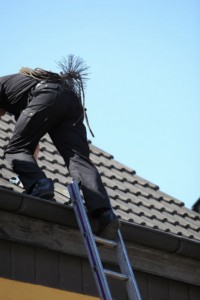As gas and oil appliances become more efficient and cost effective, more and more homeowners are opting to convert their open hearth fireplaces to gas and oil. While these new fireplace units offer minimal maintenance and are easier to operate, changing the fuel type of your fireplace may damage your chimney.
Even if your new fireplace fits into the firebox, it may not be a good fit for the chimney. Because of this, it may be recommended to have your chimney relined after installing a new fireplace unit.
Types of chimney liners
There are a number of reasons it may be recommended that you have your chimney relined, including missing a liner entirely, having a damaged chimney liner, or switching to a fireplace with a different fuel source. When having your fireplace relined, there are three main types of chimney liners: clay tile, cast in place, and metal liners.
- Clay tile liners: Clay tile liners are the standard material used for lining chimneys. Clay tiles are extremely durable and can last for 50 years or longer when correctly installed and properly maintained. However, just like your chimney a clay tile liner has masonry joints that are more susceptible to damage. Likewise, it is virtually impossible to replace cracked or broken tiles within the flue without removing a portion of the chimney.
- Cast in place liners: Cast in place liners are built using one of several poured cement processes. The lining material is literally cast directly into the flue, molding to the exact shape and size of your chimney while creating a seamless liner. Because of the insulation provided by a seamless liner, cast in place liners are known to reduce creosote accumulation and burn cleaner. Likewise, cast in place liners are can be used to reinforce a damaged chimney structure.
- Metal liners: Stainless steel liners are favored by many in the fireplace industry because of their ease of installation and durability. Likewise, stainless steel liners are available in a variety of different sizes to ensure that the flue is correctly sized for your fireplace unit. Many stainless steel liners come with a limited lifetime warranty when swept and inspected annually.
Why your old chimney may need a new lining 
Most homeowners associate having the chimney relined with damage such as a chimney fire. However, what they may not realize is that switching fuel sources can also necessitate having the chimney relined.
Fireplaces need to have a correctly sized flue in order to operate with maximum efficiency. If the flue is too big for the fireplace it will not vent properly, decreasing efficiency and leading to increased creosote buildup in the chimney. Likewise, many clay tile liners are not built to withstand the byproducts of an oil or gas fire. While wood burning fires produce creosote, gas and oil fires create a corrosive, acidic condensate. This condensate can eat away at clay tiles, causing them to quickly deteriorate. Instead, a stainless steel liner should be used to protect the rest of your home and chimney from this acidic buildup.
Whether you’re switching fuel sources or simply installing a more modern unit, your flue may no longer be correctly sized for your fireplace. Call Jack Pixley Sweeps today to learn more about how relining your chimney can improve the efficiency and safety of your new fireplace.
